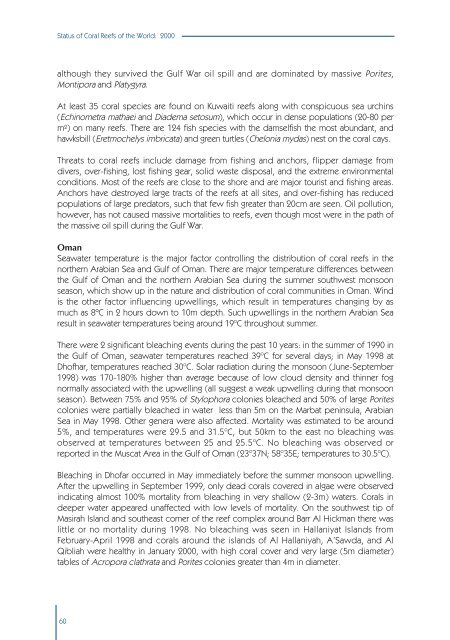Status of Coral Reefs of the World 2000
Status of Coral Reefs of the World 2000.pdf
Status of Coral Reefs of the World 2000.pdf
- No tags were found...
Create successful ePaper yourself
Turn your PDF publications into a flip-book with our unique Google optimized e-Paper software.
<strong>Status</strong> <strong>of</strong> <strong>Coral</strong> <strong>Reefs</strong> <strong>of</strong> <strong>the</strong> <strong>World</strong>: <strong>2000</strong><br />
although <strong>the</strong>y survived <strong>the</strong> Gulf War oil spill and are dominated by massive Porites,<br />
Montipora and Platygyra.<br />
At least 35 coral species are found on Kuwaiti reefs along with conspicuous sea urchins<br />
(Echinometra mathaei and Diadema setosum), which occur in dense populations (20-80 per<br />
m 2 ) on many reefs. There are 124 fish species with <strong>the</strong> damselfish <strong>the</strong> most abundant, and<br />
hawksbill (Eretmochelys imbricata) and green turtles (Chelonia mydas) nest on <strong>the</strong> coral cays.<br />
Threats to coral reefs include damage from fishing and anchors, flipper damage from<br />
divers, over-fishing, lost fishing gear, solid waste disposal, and <strong>the</strong> extreme environmental<br />
conditions. Most <strong>of</strong> <strong>the</strong> reefs are close to <strong>the</strong> shore and are major tourist and fishing areas.<br />
Anchors have destroyed large tracts <strong>of</strong> <strong>the</strong> reefs at all sites, and over-fishing has reduced<br />
populations <strong>of</strong> large predators, such that few fish greater than 20cm are seen. Oil pollution,<br />
however, has not caused massive mortalities to reefs, even though most were in <strong>the</strong> path <strong>of</strong><br />
<strong>the</strong> massive oil spill during <strong>the</strong> Gulf War.<br />
Oman<br />
Seawater temperature is <strong>the</strong> major factor controlling <strong>the</strong> distribution <strong>of</strong> coral reefs in <strong>the</strong><br />
nor<strong>the</strong>rn Arabian Sea and Gulf <strong>of</strong> Oman. There are major temperature differences between<br />
<strong>the</strong> Gulf <strong>of</strong> Oman and <strong>the</strong> nor<strong>the</strong>rn Arabian Sea during <strong>the</strong> summer southwest monsoon<br />
season, which show up in <strong>the</strong> nature and distribution <strong>of</strong> coral communities in Oman. Wind<br />
is <strong>the</strong> o<strong>the</strong>r factor influencing upwellings, which result in temperatures changing by as<br />
much as 8ºC in 2 hours down to 10m depth. Such upwellings in <strong>the</strong> nor<strong>the</strong>rn Arabian Sea<br />
result in seawater temperatures being around 19 o C throughout summer.<br />
There were 2 significant bleaching events during <strong>the</strong> past 10 years: in <strong>the</strong> summer <strong>of</strong> 1990 in<br />
<strong>the</strong> Gulf <strong>of</strong> Oman, seawater temperatures reached 39 o C for several days; in May 1998 at<br />
Dh<strong>of</strong>har, temperatures reached 30 o C. Solar radiation during <strong>the</strong> monsoon (June-September<br />
1998) was 170-180% higher than average because <strong>of</strong> low cloud density and thinner fog<br />
normally associated with <strong>the</strong> upwelling (all suggest a weak upwelling during that monsoon<br />
season). Between 75% and 95% <strong>of</strong> Stylophora colonies bleached and 50% <strong>of</strong> large Porites<br />
colonies were partially bleached in water less than 5m on <strong>the</strong> Marbat peninsula, Arabian<br />
Sea in May 1998. O<strong>the</strong>r genera were also affected. Mortality was estimated to be around<br />
5%, and temperatures were 29.5 and 31.5 o C, but 50km to <strong>the</strong> east no bleaching was<br />
observed at temperatures between 25 and 25.5 o C. No bleaching was observed or<br />
reported in <strong>the</strong> Muscat Area in <strong>the</strong> Gulf <strong>of</strong> Oman (23 o 37N; 58 o 35E; temperatures to 30.5 o C).<br />
Bleaching in Dh<strong>of</strong>ar occurred in May immediately before <strong>the</strong> summer monsoon upwelling.<br />
After <strong>the</strong> upwelling in September 1999, only dead corals covered in algae were observed<br />
indicating almost 100% mortality from bleaching in very shallow (2-3m) waters. <strong>Coral</strong>s in<br />
deeper water appeared unaffected with low levels <strong>of</strong> mortality. On <strong>the</strong> southwest tip <strong>of</strong><br />
Masirah Island and sou<strong>the</strong>ast corner <strong>of</strong> <strong>the</strong> reef complex around Barr Al Hickman <strong>the</strong>re was<br />
little or no mortality during 1998. No bleaching was seen in Hallaniyat Islands from<br />
February-April 1998 and corals around <strong>the</strong> islands <strong>of</strong> Al Hallaniyah, A’Sawda, and Al<br />
Qibliah were healthy in January <strong>2000</strong>, with high coral cover and very large (5m diameter)<br />
tables <strong>of</strong> Acropora clathrata and Porites colonies greater than 4m in diameter.<br />
60
















